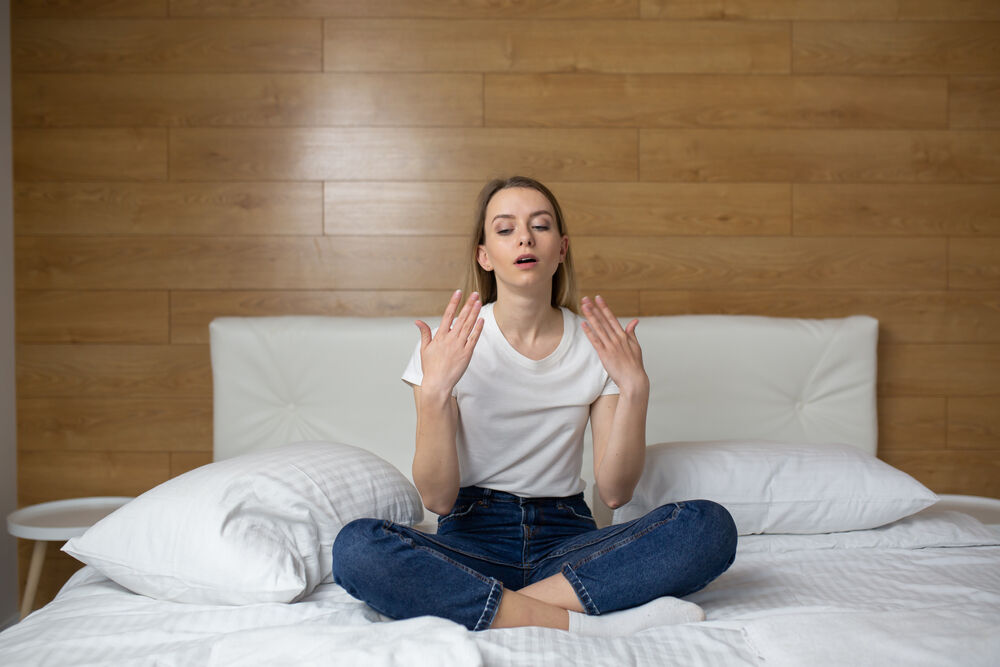You know the routine: It’s the middle of a summer night, and you’ve woken up hot, sweaty, and tangled in damp bedding. You fling back the covers. You dangle your feet outside the blankets. You flip your pillow to the cool side. If you’re lucky, you’ll doze off again once you cool down, but even if you do, you’ve already lost some of your precious deep sleep time.
Luckily, you can avoid the too-hot tossing-and-turning tango with a few easy-to-follow tips and simple adjustments to your sleep routine if you’re a hot sleeper, even without an air conditioner!
In this article, we’ll explore why room temperature is so vital to good sleep and show you exactly how to stay cool at night with 15 of our coolest sleep tips.
The Science of Cool Sleep
If you often find yourself sleeping poorly thanks to the hot weather, overheating, or night sweats, you’re not alone. Sleeping too hot is a common reason for broken sleep and it doesn’t only happen in the dog days of summer. Sleeping too hot can happen when:
- Your bedroom is too warm due to hot air build up or poor air circulation or a thermostat set too high
- Your bedding doesn’t allow enough airflo
- Age, medication, or illness has affected your body’s ability to regulate your core temperature
- Your bedtime routine interferes with natural temperature regulation
Interestingly, sound sleep and body temperature go hand-in-hand. Your core temperature naturally starts to drop about two hours before bed. This drop in room temperature signals your body to start producing melatonin (the sleep hormone) so that you can drift off to dreamland. Overnight, your core temperature continues to drop until the morning hours when it gradually rises again.
However, if health problems, a heat wave, or hot bedding disrupt this flow, you’ll find yourself suffering from poor sleep.
15 Tips for Cooler Sleep
Now that you know how important temperature is for good sleep, let’s get into how you can keep yourself—and your bedroom—cool and comfortable.
#1 Invest in a Cooling Mattress
As mentioned earlier, your core body temperature continues to drop as you sleep. The heat you lose is absorbed by your bedding to create a cozy microclimate around you. But if your mattress traps all that excess heat without gradually dispersing it, you’ll end up overheating.
New types of mattresses with cooling technology can help regulate core body temperature by efficiently moving excess body heat away from your skin. For instance, the TEMPUR-LuxeBreeze from TEMPUR-pedic is the best mattress choice that uses special heat-absorbing fibers to make the mattress surface feel up to 10 degrees cooler than a traditional mattress.
Read our Latest Buyer's Guide: Best Cooling Mattresses - Reviewed by Experts
#2 Add a Cooling Mattress Pad
Can’t upgrade the mattress before the heat wave is over? No problem—the modern mattress topper can also provide cooling relief.
Cooling mattress toppers include features like:
- Memory foam with ventilation to optimize airflow
- Gel foams infused with additives like copper and graphite that conduct heat away from the body
- Mineral-based fiber fillings that create a cool-to-the-touch surface
#3 Set the Proper Temperature
Our bodies are naturally good at keeping our temperature in the perfect zone for better sleep quality. However, when the room around you is too warm, it interferes with this delicate balancing act. Just a small swing out of the ideal range has been shown to result in effects like:
- Difficulty falling asleep
- Grogginess
- Memory problems
- Mood changes and irritability
For this reason, the ideal sleeping temperature should stay between about 66 and 70 degrees Fahrenheit.
#4 Keep Your Room Dark
In hot climates like Mexico and the Mediterranean, houses are designed with thick walls and heavy shutters to keep interiors dark and cool. You can put this strategy to work for you by keeping your bedroom curtains shut during the day. Blocking out sunlight can help ensure your room is cool and comfortable by the time you’re ready for bed.
#5 Purchase a Cooling Pillow
Like a cooling mattress, cooling pillows are specially designed to keep body heat from a hot sleeper moving away from your skin, leaving the surface refreshing and cool. Choose a pillow with:
- Foam or fiber construction
- Vents or cells for optimal air flow
#6 Do the Mr. Freeze
A few hours before bedtime, place your pillowcase or a damp washcloth in the freezer. This way, when you’re ready to go to sleep, your pillowcase will be extra cool and refreshing.
You can also place the frozen washcloth on areas of your body that tend to heat up overnight, like:
- Across your forehead
- Against the back of your neck
- Behind your knees or at the crook of the elbows
- On or near your feet
#7 Use Cooling Bedding
For extra comfort, why not double down on your cooling gel mattress (or cooling mattress topper) with cooling bedding? Like other cooling materials, cooling bedding is designed to disperse the excess heat away from your body.
Here are some tips for choosing the coolest sheets and pillowcases:
- Avoid soft weaves like brushed cotton or jersey that trap heat with tiny fibers
- Choose smooth weaves like sateen or percale for a cool-to-the-touch surface that lets heat escape quickly
- Look for advanced fiber blends like Tencel Lyocell and nylon fibers used in Tempur-Pedic Breeze cooling sheets—these are optimized to wick moisture and heat away from the skin
#8 Stay Hydrated
Your body uses sweat to help you cool down, even during sleep. However, if you’re dehydrated, your body can’t cool you as efficiently.
To that end, ensure you’re drinking enough water throughout the day. Most adults need about 64 ounces of water (that’s six 8 oz. glasses) each day to replace normal moisture loss.
If you’re sweating heavily due to night sweats, exercise, or hot weather, you’ll need to drink even more water. Just remember: you want to drink water during the day, not right before bedtime, to avoid nighttime bathroom visits.
#9 Dress Appropriately
If you’re frequently waking up too hot, your pajamas could be to blame. To stay cool, opt for light cotton sleepwear that allows maximum breathability, and keep these other tips in mind:
- Go for minimal coverage like shorts and a tee or tank—the more exposed skin you have, the more efficiently your body can cool off.
- Allow for enhanced air flow—choose a loose fit over something skin-hugging.
#10 Take a Warm Shower or Bath Before Bed
While being too warm at night disrupts sleep, warming up a few hours before bed can actually help you fall asleep more quickly and sleep more deeply. One proven way to do this is with a warm (not hot) bath a few hours before bedtime.
The cool-down that follows getting out of a warm bath can kick-start a feeling of sleepiness and ensure that you’ll stay asleep longer.
#11 Get Cross-Ventilation
Airflow in the bedroom is vital for moving heated air away from your skin. Two windows on opposite walls are ideal for airflow, but most bedrooms don’t offer this layout. Instead, try:
- Opening the bedroom door and positioning a fan across the room facing it
- Place two fans facing each other on opposite sides of the room
- Place a box fan in your window blowing outward to push hot air out and pull cool air in
#12 Spread Out
Try sleeping flat on your back with your arms and legs spread out to let your body heat dissipate. Of course, this works best with plenty of room. If you share your bed, consider alternate sleeping arrangements during hot spells:
- Have you or your partner sleep in the guest room temporarily
- Move pets to their pet beds
#13 Avoid Exercising at Night
While you can still get your daily workout in, try to schedule it earlier in the day. Why?
Your core temperature can stay elevated for 90 minutes after a workout, or even longer depending on factors like age, physical fitness, and chronic illness. With an elevated core temperature, you’ll have a harder time winding down (and cooling off) for the night.
#14 Cut the Caffeine
You may already know that a cup of coffee won’t help you sleep. But it’s not just due to the energy boost and alertness caffeine can provide. Research has found that caffeine consumption can also:
- Increase core body temperature
- Decrease the body’s ability to cool down by restricting bloodflow to the extremities (arms and legs)
As we’ve seen, cooling down is key to sleep. So, even if you’re one of those people who doesn’t notice a pick-me-up from caffeine, it can still interfere with your body’s bedtime cool-down process.
#15 Create Your Own Cool Breeze
No air conditioner? No problem—you can create a DIY breeze with ice and an electric fan:
- Fill a large bowl with ice and place it in front of a fan aimed at your bed
- As the ice melts, the fan will blow chilled, moist air through the room
The closer the fan is to your bed, the more you’ll feel the cooling breeze.
Stay Frosty and Snooze Soundly With Mancini’s Sleepworld
With these cooling sleep tips, you can beat the heat and ensure restful, restorative nights of sleep—even during a hot summer night.
Need to outfit your bedroom with cooling sleep essentials? Let the sleep expert at Mancini’s Sleepworld help you find your perfect matches by exploring our collection of mattresses, bedding, and more today.
Sources:
- Frontiers in Neuroscience. The temperature dependence of sleep. https://www.frontiersin.org/articles/10.3389/fnins.2019.00336/full
- Journal of Applied Physiology. Restoration of thermoregulation after exercise. https://journals.physiology.org/doi/full/10.1152/japplphysiol.00517.2016
- Journal of Biological Rhythms. Effects of caffeine on skin and core temperatures, alertness, and recovery sleep during circadian misalignment. https://journals.sagepub.com/doi/10.1177/0748730414523078?

